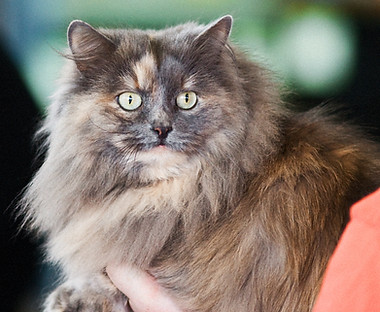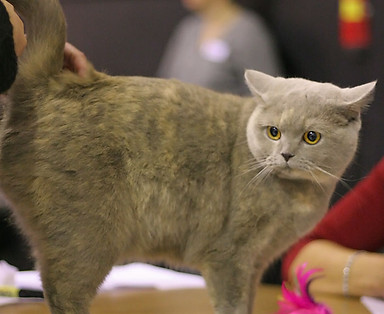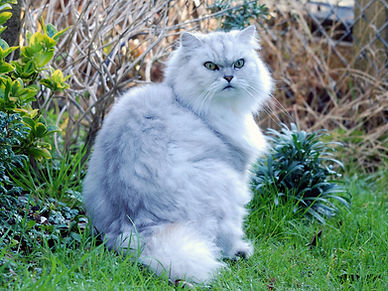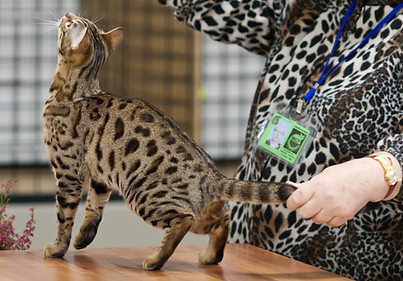a visual glossary
of cat colors and patterns
This is a glossary of cat colors and patterns with photographic examples. I've included photos available under Creative Commons when possible, but for some of the rarer patterns I've linked to photos instead.
For rarer colors and patterns I haven't listed, I highly recommend taking a look at Messybeast's color and pattern charts.
colors
black
Synonyms: Ebony. In solid black cats, the nose and paw-pads will also be black. Some black cats, especially longhairs, may have a reddish cast in the sun, or a brownish tone from sun exposure.

chocolate
Synonyms: Chestnut. A dark brown cat. There is some variation in shade. The nose and paw-pads will also be chocolate.

Source: Sloan Poe on Flickr
Source: c h e e s e roc on Flickr
cinnamon
Synonyms: Sorrel (in Abyssinians/Somalis). A lighter reddish-brown, "the color of a cinnamon stick". Nose and paw-pads will be the same color or more pink.
red
Synonyms: Orange, Yellow, Marmalade, Ginger. Anywhere from rich red-orange to a washed out yellow. The nose and paw-pads are pink or coral. "Solid" red cats are generally specifically bred to have as few markings as possible, since true solid red cats are not possible.

Source: Heikki Siltala at catza.net

Source: jim simonson on Flickr
blue
Synonyms: Grey. A grey cat, with a wide range of colors from pale blue-grey to deep slate. Nose and paw-pads are generally also blue, but may be darker than the coat.
lilac
Synonyms: Lavender. A warm grey-brown, or "grey with a pinkish tone". Can vary in shade. Nose and paw-pads are lilac or lilac-pink, and may be darker than the coat.
_RUS_male.jpg)
Source: Heikki Siltalla at catza.net

Source: Heikki Siltala at catza.net
fawn
Synonyms: Beige. A beige color, lighter and warmer than lilac. Although it is ideally easy to distinguish from lilac, darker fawns can be difficult to identify. Nose and paw-pads are warm brownish-pink.
cream
Pale yellow or tan, sometimes with a slight pinkish cast. Nose and paw-pads are pink. Like with red, cream cats cannot be solid, and any that appear solid simply have very low-contrast markings.

Source: Heikki Siltala at catza.net

caramel
Synonyms: Taupe. Caramel is a rare color caused by the action of the "dilute modifier" gene on blue, lilac, or fawn cats. It is a grey-brown, similar to lilac. "Taupe" specifically refers to lilac-based caramel.
apricot
Apricot is caused by the same dilute modifier as caramel, but on cream. It is paler than ginger, but more saturated than cream. Because it is derived from cream, there are no true solid apricot cats.
white
Fully white cats have pink noses and paw-pads. White cats also have a higher incidence of heterochromia or "odd eyes", where each eye is a different color - usually one blue eye and one eye of another color.

Source: Lite at Russian Wikipedia
tortoiseshells
Synonyms: Tortie, Particolor. Tortoiseshells are cats, typically only female, which have patches of a "red" color (red, cream, or apricot), and patches of a "black" color (any of the other colors listed above). The "red" color may display tabby markings even though the "black color is solid.
tortoiseshell
"Normal" tortoiseshells have patches of black and red. The nose and paw-pads may be mottled between black and pink.
chocolate tortoiseshell
Chocolate torties are patched with chocolate and red. The nose and paw-pads may be mottled between chocolate and pink.

Source: Taryn on Flickr.

Source: Heikki Siltala at catza.net
cinnamon tortoiseshell
Cinnamon torties are patched cinnamon and red. The nose and paw-pads may be mottled between cinnamon and pink.
dilute tortoiseshell
Dilute tortoiseshells are blue and cream. The nose and paw-pads may be mottled blue and pink.

Source: Heikki Siltala at catza.net

Source: Heikki Siltala at catza.net
lilac tortoiseshell
Lilac torties are lilac and cream. The nose and paw-pads may be mottled lilac and pink.
fawn tortoiseshell
Fawn tortoiseshells are fawn and cream. The nose and paw-pads may be mottled brownish-pink and pink.

Source: Heikki Siltala at catza.net
caramel tortoiseshell
Caramel torties are caramel and apricot. The nose and paw-pads may be mottled caramel and pink.
tabbies
A tabby cat has a dark pattern overlaid on a lighter, ticked background color. There are four main types of tabby: classic tabby (also known as blotched or oyster tabby), which has bold stripes that make a "bullseye" marking on the side, mackerel tabby, which has thinner vertical stripes, spotted tabby, where the markings are broken up into small spots, and ticked tabby, which has no distinct stripes except for some residual striping on the legs, tail, and neck.
Red, cream, and apricot tabbies are not shown here because these cats are always tabbies, so examples can be found above.
black tabby
More commonly known as brown tabby. The background color may be almost black, light grey or brown, rich red-brown, or anything in between, but they can always be identified by their black stripes.
The nose can be black or dark red rimmed with black.
The pictured cat is a mackerel tabby.
chocolate tabby
Chocolate tabbies have a tan background color and chocolate markings. The nose can be chocolate or pinkish rimmed with chocolate.
The pictured cat is a classic tabby.


Source: Heikki Siltala at catza.net
Source: Heikki Siltala at catza.net
blue tabby
Blue tabbies have a background color of light grey or warm beige with blue markings. The nose can be blue or old rose rimmed with blue.
The pictured cat appears to be a broken mackerel, intermediate between mackerel and spotted.
cinnamon tabby
Cinnamon tabbies have a tan background color similar to that of chocolate tabbies, but with cinnamon markings. The nose is pinkish-cinnamon or pink rimmed with cinnamon.
The pictured cat is a spotted tabby.

Source: Heikki Siltala at catza.net

Source: Heikki Siltala at catza.net
lilac tabby
Lilac tabbies have a light beige background color and lilac markings. The nose is lilac or pink rimmed with lilac.
The pictured cat is a ticked tabby.
fawn tabby
Fawn tabbies tend to be very low contrast, with the background color only slightly lighter than the markings. The nose is pink.
The pictured cat is a spotted tabby.


Source: Heikki Siltala at catza.net
Source: Heikki Siltala at catza.net
tortoiseshell tabbies
Tortoiseshell tabbies, also known as torbies or patched tabbies, have tabby markings across both colors. They come in every color of tortoiseshell.
The pictured cat is a classic black torbie.

Source: Heikki Siltala at catza.net
silver, smoke, and golden
silver tabbies
Silver tabbies have a silvery background color and colored stripes. They come in every color and pattern of tabby.

silver shaded and tipped
Silver shaded cats are light silver ticked tabbies. The lightest of them may be referred to as silver tipped, because the hairs are tipped with color.
.jpg)
Source: Heikki Siltala at catza.net
smoke
The smoke pattern is caused by the silver gene acting on solid cats. Smoke cats have a silvery undercoat, best seen in longhaired cats.
"smoke tabbies"
"Smoke tabbies" are not tabbies at all. They are smoke cats, usually shorthaired, who show faint tabby markings. This is especially common in kittens.


Source: Heikki Siltala at catza.net
golden tabby
Golden tabbies have a bright golden background color and colored stripes. They come in every color and pattern of tabby.
I had difficulty finding a usable picture of a true golden tabby, so here is a link to cattery no Demetra's photo gallery. They specialize in silver and golden British shorthairs, so you can find lots of great examples.
golden shaded and tipped
As with silver, golden shaded cats are light golden ticked tabbies. They may also be tipped.

Source: Heikki Siltala at catza.net
colorpoint, mink, and sepia

colorpoint
Colorpoint is known as the typical Siamese pattern, but it also appears in other breeds. Colorpoint cats have a light body, colored extremities, and blue eyes. Older colorpoints or cats living in colder climates tend to be more darkly shaded.
mink
Mink is the signature pattern of the Tonkinese. Mink cats are darkly colored at the extremities, but the body is not as light as in colorpoint cats. They typically have green or blue-green eyes.

Source: Heikki Siltala at catza.net
sepia
Sepia is the pattern of the Burmese. It is the darkest version of the pattern, and can sometimes be difficult to make out. Burmese cats have gold eyes by breed standard, but other eye colors are possible.

Source: Heikki Siltala at catza.net
white spotting
White spotting is the most common type of white markings in cats. It ranges from very small white markings to markings covering almost the entire body. Very low levels of white spotting present as a white chin, chest spot, tail-tip, and/or toes, and as the amount of white increases it progresses to the face, chest, belly, legs, all the way up to the van pattern. White spotting can combine with any color and pattern.
mitts
Mitts or socks are one of the first areas of white to appear. There is also an allele that specifically causes white mitts found in the Birman breed.
tuxedo
Tuxedo patterned cats have a white chest, partial or complete white muzzle, toes, and possibly a white tail-tip or white belly.


Source: Heikki Siltala at catza.net
bicolor
Bicolor is a term for (non-tortoiseshell) cats with roughly half white. However, it is sometimes used for a wider range of white spotting.
mask and mantle
Mask and mantle cats have two large masses of color - one on the head (the "mask), and one on the body (the "mantle").


Source: Heikki Siltala at catza.net
Source: Hisashi on Flickr.
cap and saddle
The cap and saddle pattern is similar to the mask and mantle, but each mass of color is smaller.
harlequin
Harlequin cats have random spotting with a colored tail. Cats with random spotting and no colored tail are pied.

_edited.jpg)
Source: Hisashi on Flickr
Source: B. Proksch via Wikimedia Commons
Source: B. Proksch via Wikimedia Commons
van pattern
Van patterned cats are mostly white with colored splotches between the ears and a colored tail.
calico
Also known as tricolors, calicos are tortoiseshells with over half white spotting. The patches tend to be larger and more distinct. Low-white tortoiseshells are more commonly called tortoiseshell and white.


Source: Heikki Siltala at catza.net
Source: Heikki Siltala at catza.net
Source: Heikki Siltala at catza.net
Source: Heikki Siltala at catza.net
breed specific colors and patterns
ruddy (abyssinian/somali)
Abyssinians and Somalis are bred to have a lot of red pigment, which gives them unique coloration. Black tabby becomes ruddy (also called usual or tawny), a rich red ticked with black. Cinnamon tabby is called sorrel, and is red with cinnamon ticking. Other colors do not change names, but all have distinct red or cream undertones.
sepia (singapura)
Singapuras, in contrast to Abyssinians and Somalis, have very little red pigment. For them, black tabby becomes sepia, an ivory color with black ticking.

Source: Heikki Siltala at catza.net
Source: Heikki Siltala at catza.net
Source: Heikki Siltala at catza.net

Source: Heikki Siltala at catza.net
_JPG.jpg)
agouti tabby (aby/somali/singapura)
Agouti tabby is ticked tabby without banding on the legs, tail, and neck. It must be bred for, since it only appears in these breeds and crosses thereof.
sunshine and bimetallic (siberian)
Siberians have a special type of "golden tabby" known more specifically as sunshine. It is known to be distinct because silver sunshine cats, or bimetallics, have patches of silver and "golden".

Source: Heikki Siltala at catza.net
Source: Heikki Siltala at catza.net
amber (norwegian forest cat)
Amber is a color particular to Norwegian Forest Cats. The cat is born a black-based tabby, then gradually lightens until they are similar in color to a ginger cat, possibly with some residual black pigment.
nonagouti amber (norwegian forest cat)
In non-tabbies, amber acts a bit differently. As they lighten, they retain dark stripes. They can also be identified by their dark noses.

.jpg)
Source: Sylvie MM on Flickr.
rosetted tabby
Rosetted tabby is one of the two signature patterns of the Bengal breed. It varies widely in appearance, from small to very large rosettes, but the general pattern is spots with a dark border and lighter center.
marbled tabby
Marbled tabby is modified classic tabby. The pattern tends to be very rectangular, with lighter spots in the middle of the stripes.
asian leopard cat patterns
These patterns can be found in breeds with ancestry in the Asian Leopard Cat, such as Bengals and Toygers. They arise from the combination of ALC genes with domestic cat genes.


Source: Heikki Siltala at catza.net
Source: Heikki Siltala at catza.net
Source: Heikki Siltala at catza.net
charcoal
Charcoal is a Bengal trait that comes in two forms, "twilight" and "midnight". Both types have dark markings on the face and back, with those of midnight charcoals being darker than those of twilight charcoals. They also show reduced red pigment, though not to the same extent as silver cats.
"Twilight charcoal" and "midnight charcoal" were coined by Traipse Charcoal Bengals. They elaborate and show examples of each here!
braided tabby
Also known as "candle-flame" tabby, braided tabby is the pattern of the Toyger. It is a modification of mackerel tabby. The mackerel stripes tend to split longitudinally, with areas of medium darkness in between.

Source: Heikki Siltala at catza.net